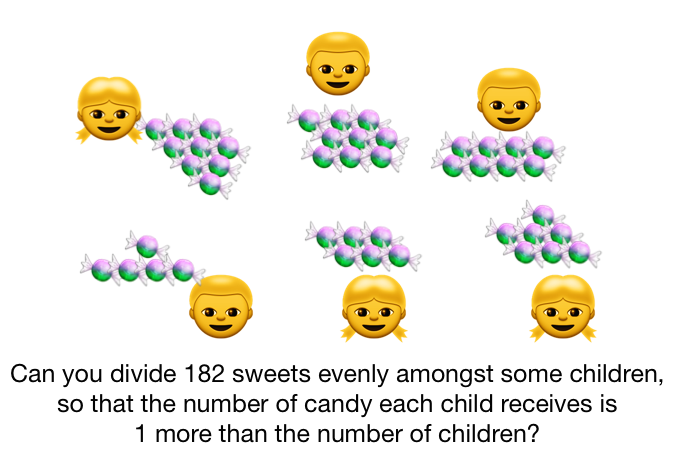They Divide Nicely

182 sweets are equally divided among a certain number of children at a party. If the number of sweets each child receives is one more than the number of children, find the number of children at the party.
The answer is 13.
This section requires Javascript.
You are seeing this because something didn't load right. We suggest you, (a) try
refreshing the page, (b) enabling javascript if it is disabled on your browser and,
finally, (c)
loading the
non-javascript version of this page
. We're sorry about the hassle.
3 solutions
I use the same method
They were integers, so I guessed-and-checked.
A simple multiplication will be enough to get the answer:
1 3 × 1 4 = 1 8 2
But that would mean that you're testing values one by one until you get it
Log in to reply
Yes I was testing the values but not one by one.
The number of candies given to a child is one greater than the number of children.
So that means ( n ) × ( n + 1 ) = 1 8 2 .
Now think of the two numbers with this result.
It is obvious that, they cannot be greater than 15 as 15×16=240.
And cannot be less than 10 as 10×11=121.
This can be applied for smaller numbers, but for larger numbers we will have to go through the conventional way only(like you did).
Log in to reply
There is one more method, just factorise 182.
1 8 2 ⇒ 1 3 × 7 × 2 ⇒ 1 3 × 1 4
There we get our answer!
Log in to reply
@Yash Jain – Yes, this looks good. :)
Log in to reply
@Abhay Tiwari – Kinda similarly I checked integers, but to narrow the field, i took the sqrt(182) and got 13.5, so the first numbers I checked were 13 and 14 and it worked!
Log in to reply
@Connor Jennison – Ya, this is good too, gets you the idea for the values, good one :)
Let the number of children be x . The number of candy each child gets is x + 1
Therefore, we have the equation:
x 1 8 2 = x + 1 1 8 2 = x ( x + 1 ) x 2 + x − 1 8 2 = 0 ( x + 1 4 ) ( x − 1 3 ) = 0 x = − 1 4 , 1 3
Since we know that x > 0 , the number of children is x = 1 3